In the face of climate change and environmental degradation, the construction industry is undergoing a transformative shift towards sustainable and eco-friendly building practices.
Green building, also known as sustainable or eco-friendly construction, focuses on minimizing the environmental impact of structures throughout their entire life cycle.
From design and construction to operation and eventual demolition, green building aims to create structures that are resource-efficient, environmentally responsible, and conducive to the well-being of occupants.
The Essence of Green Building:
Green building encompasses a broad spectrum of practices that prioritize energy efficiency, water conservation, and the use of environmentally friendly materials. The adoption of renewable energy sources, waste reduction, and the promotion of a healthy indoor environment are integral components of green building initiatives. The goal is not only to reduce the negative impact of construction on the environment but also to enhance the quality of life for those who inhabit these spaces.
- Sustainable Site Planning and Design:
Green building starts with careful consideration of the site itself. Sustainable site planning involves minimizing disruption to the natural environment, preserving existing vegetation, and incorporating landscaping that requires minimal water usage. The orientation of the building is also crucial, taking advantage of natural sunlight for heating and reducing the need for artificial lighting.
- Energy Efficiency:
One of the cornerstones of green building is energy efficiency. This involves optimizing the building’s design to reduce energy consumption, utilizing energy-efficient appliances and systems, and incorporating renewable energy sources such as solar panels or wind turbines. The integration of smart technologies, such as energy-efficient lighting and HVAC systems, further enhances a building’s energy performance.
- Water Conservation:
Green buildings prioritize water conservation through the use of efficient plumbing fixtures, rainwater harvesting systems, and landscaping that minimizes water consumption. Greywater recycling systems, which treat and reuse water from showers and sinks, contribute to reducing overall water usage and promoting sustainable water management.
- Environmentally Friendly Materials:
The selection of construction materials significantly impacts a building’s environmental footprint. Green building promotes the use of recycled, reclaimed, or rapidly renewable materials. Additionally, the sourcing of materials locally reduces transportation-related emissions and supports the local economy. Sustainable certifications, such as LEED (Leadership in Energy and Environmental Design), guide builders in choosing materials with low environmental impact.
- Indoor Environmental Quality:
Green building prioritizes the health and well-being of occupants by focusing on indoor air quality, lighting, and thermal comfort. The use of non-toxic materials, proper ventilation systems, and natural daylighting contribute to a healthier indoor environment. This emphasis on occupant comfort and health is a significant departure from traditional construction practices that often overlooked these critical aspects.
- Waste Reduction and Recycling:
Minimizing construction waste is another key principle of green building. This involves careful planning to reduce excess materials, recycling construction waste, and using recycled materials whenever possible. Adopting a cradle-to-cradle approach, where materials are designed for easy disassembly and recycling, further promotes a circular economy within the construction industry.
Challenges and Future Outlook:
While the green building movement has made significant strides, challenges remain. Initial costs, perceived complexities, and resistance to change are hurdles that need to be addressed. However, the long-term benefits, both environmentally and economically, far outweigh these challenges. Governments, businesses, and individuals are increasingly recognizing the importance of sustainable construction, and incentives and regulations are being put in place to encourage its adoption.
Conclusion:
Green building represents a paradigm shift in the way we approach construction, emphasizing environmental responsibility, resource efficiency, and occupant well-being.
As the world grapples with the urgent need to address climate change, green building stands as a beacon of hope, showcasing how innovative design and construction practices can create a sustainable and harmonious balance between human activities and the natural environment.
By embracing the principles of green building, we not only construct buildings but also contribute to the creation of a healthier, more resilient, and sustainable future.
To see other material construction prices, please see here.
To know other construction guides, tips, and methodology for beginners, veterans, and contractors, please see here.

